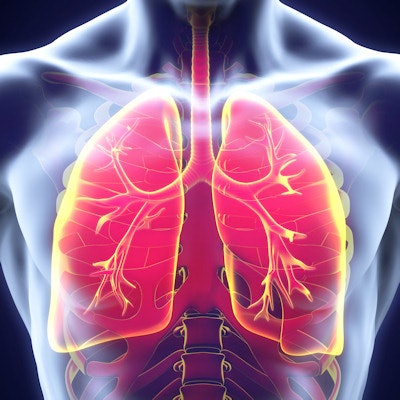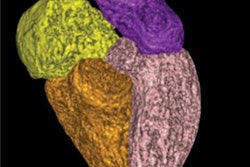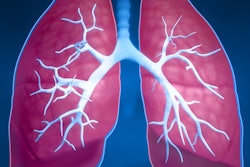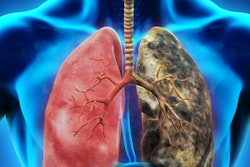
Measurements of lung nodule volume on CT scans made with computer-aided diagnosis (CADx) software were more accurate than conventional measurements of nodule diameter in predicting the recurrence of subsolid lung cancer in patients who underwent surgery, according to a recent study published in Radiology.
Researchers from Japan evaluated the effectiveness of predicting the recurrence of non-small cell lung cancer (NSCLC) in patients using three techniques:
- Nodule diameter on 2D CT scans
- Nodule diameter on 3D multiplanar reconstructed CT scans
- Nodule volume calculated by CADx volumetry software
Among these three different approaches, assessing nodules via CADx volumetry produced the most accurate predictions, with an average area under the curve of 0.835 (Radiology, March 14, 2018).
"The volumetry of the solid component of part-solid non-small cell lung cancer shows better correlation with postoperative recurrence and prognosis than does the conventional diameter measurement," wrote first author Dr. Shinichiro Kamiya and colleagues at Nagoya University.
Measuring lung cancer nodules
The poor prognosis associated with advanced lung cancer underscores the importance of obtaining the most precise evaluation of nodules as possible, according to the authors. In the case of subsolid tumors, the traditional -- and perhaps simplest -- method involves measuring the diameter of the solid part of these tumors on CT scans. However, these measurements occasionally turn out to be inaccurate due to the inherently irregular shape of the tumors.
Several other options for collecting the dimensions of subsolid tumors have emerged in recent years, including measuring the diameter on multiplanar reconstructions of 3D CT scans or calculating volume using CADx volumetry software. Prior research has demonstrated that these techniques can help predict lung cancer malignancy and postoperative recurrence, they wrote.
On that basis, the group decided to compare the ability of various techniques to predict the reappearance of tumors in patients after they underwent lung cancer surgery. The investigation included 96 patients who underwent surgical removal of subsolid NSCLC and follow-up CT every six to 12 months after the procedure. The participants consisted of 47 men and 49 women, and their average age was 66 years.
One radiology resident and one chest radiologist with more than 20 years of experience read the preoperative chest CT scans of these patients and recorded the longest diameter of the subsolid tumors, as well as the longest diameter of only the solid portion of the tumors. The radiologists also performed a similar measuring task on 3D multiplanar reconstructions of the same CT scans, which the researchers had previously formatted in a 3D workstation (Synapse Vincent, Fujifilm Medical Systems).
Finally, the two readers used CADx volumetry software to calculate the volume of entire individual subsolid nodules on CT automatically, as well as the volume of just the solid part of the nodules. They used cutoff density values ranging from 0 Hounsfield units (HU) to 300 HU to determine whether part of a subsolid nodule was solid.
The agreement between the two readers was "almost perfect" for all diameter and volume measurements.
Predicting lung cancer recurrence
Analyzing the radiologists' measurements, Kamiya and colleagues confirmed that each of the techniques for measuring nodule size was viable for predicting the recurrence of lung cancer -- but to varying degrees.
The predictive value was highest for CADx volumetry measurements, followed by nodule diameters on normal CT scans and nodule diameters on 3D multiplanar reconstructed CT scans. Only the difference between average CADx volumetry and 3D CT measurements was statistically significant (p < 0.017).
For the three techniques, measurements considering solely the solid part of subsolid nodules had a stronger association with accurate recurrence prediction than did measurements of entire subsolid nodules (p < 0.001).
| Comparison of 3 techniques for predicting lung tumor recurrence | |||
| 2D CT | 3D CT | CADx volumetry | |
| Area under the curve | 0.796 | 0.776 | 0.835 |
| Sensitivity | 0.80 | 0.867 | 0.933 |
| Specificity | 0.704 | 0.679 | 0.716 |
"Computer-aided volumetry of the solid component in subsolid lung cancers at multidetector CT more accurately correlated with postoperative recurrence than did 2D and 3D diametrical measurements," they wrote.
The researchers also found that patients whose maximal tumor volume was less than 0.54 cm3 had a much better prognosis than those whose volume was 0.54 cm3 or greater (p < 0.001). As a point of reference, 0.52 cm3 is the volume of a sphere with a diameter of 1 cm.
A key limitation of the retrospective study was that the radiologists had to obtain the nodule diameters -- but not the volumes -- without CAD, even though prior research has suggested that CAD is better than visual inspection for evaluating subsolid lung nodules.
Presently, clinicians try various strategies to help them predict whether lung cancer will reappear after patients undergo surgical removal of tumors, the authors noted. The standard method for predicting the recurrence of subsolid nodules has been to determine the size of the solid area of a nodule on CT, although the use of FDG-PET/CT for NSCLC patients has been growing in popularity in recent years.
"For subsolid tumors, 3D solid [volumetry measurements] may be an alternative biomarker to conventional solid size measurements as a predictor of prognosis," they concluded.



















